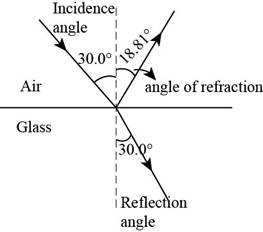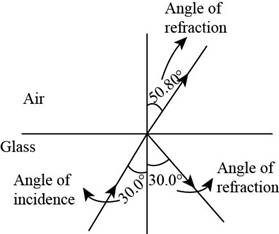
Concept explainers
Consider a horizontal interface between air above and glass of index of refraction 1.55 below. (a) Draw a light ray incident from the air at angle of incidence 30.0°. Determine the angles of the reflected and refracted rays and show them on the diagram. (b) What If? Now suppose the light ray is incident from the glass at an angle of 30.0°. Determine the angles of the reflected and refracted rays and show all three rays on a new diagram. (c) For rays incident from the air onto the air–glass surface, determine and tabulate the angles of reflection and refraction for all the angles of incidence at 10.0° intervals from 0° to 90.0°. (d) Do the same for light rays coming up to the interface through the glass.
(a)
Answer to Problem 35.52AP
Explanation of Solution
Given info: The index of refraction of glass is
From, law of reflection, the angle of incidence is equal to the angle of reflection.
Thus, angle of reflection is
From Snell’s law,
Here,
Substitute
The figure below shows the angle of incidence, the angle of reflection and the angle of refraction.

Figure (1)
Conclusion:
Therefore, the angle of reflection is
(b)
Answer to Problem 35.52AP
Explanation of Solution
Given info: The index of refraction of glass is
From, law of reflection, angle of incidence is equal to angle of reflection.
Thus, angle of reflection is
From, Snell’s law,
Here,
Substitute
The figure below shows the angle of incidence, the angle of reflection and the angle of refraction.

Figure (2)
Conclusion:
Therefore, the angle of reflection is
(c)
Answer to Problem 35.52AP
| Angle of incidence | Angle of reflection | Angle of refraction |
|
|
|
|
|
|
|
|
|
|
|
|
|
|
|
|
|
|
|
|
|
|
|
|
|
|
|
|
|
|
|
|
|
|
|
|
|
|
|
|
Explanation of Solution
From, law of reflection, the angle of reflection is equal to the angle of incidence. So for all value of angles between
The formula to calculate the angle of refraction is,
From, Snell’s law,
Substitute
Substitute
The remaining values of the angle of refraction can be calculated by the same method.
The table for angle of reflection and angle of refraction for all angles of incidence at
| Angle of incidence | Angle of reflection | Angle of refraction |
|
|
|
|
|
|
|
|
|
|
|
|
|
|
|
|
|
|
|
|
|
|
|
|
|
|
|
|
|
|
|
|
|
|
|
|
|
|
|
|
Conclusion:
Therefore, the angle of reflection is same as the angle of incidence and the of angle of refraction for rays incident from air onto the air-glass surface is increasing as angle of incidence is increasing.
The table for angle of reflection and angle of refraction for all angles of incidence at
| Angle of incidence | Angle of reflection | Angle of refraction |
|
|
|
|
|
|
|
|
|
|
|
|
|
|
|
|
|
|
|
|
|
|
|
|
|
|
|
|
|
|
|
|
|
|
|
|
|
|
|
|
(d)
Answer to Problem 35.52AP
The table for angle of reflection and angle of refraction for all angles of incidence at
|
Angle of incidence(
(
|
Angle of reflection(
|
Angle of refraction(
|
|
|
|
|
|
|
|
|
|
|
|
|
|
|
|
|
|
|
|
|
|
|
|
|
|
|
|
|
|
|
|
|
|
|
|
|
|
|
|
|
Explanation of Solution
From, the law of reflection, angle of reflection is equal to the angle of incidence. So, for all value of angles between
The formula to calculate the angle of refraction is,
From, Snell’s law,
Substitute
Substitute
The remaining values of the angle of refraction can be calculated by the same method.
The formula to calculate the critical angle is,
Here,
Substitute
The angle of incidence is greater than
The table for angle of reflection and angle of refraction for all angles of incidence at
|
Angle of incidence(
(
|
Angle of reflection(
|
Angle of refraction(
|
|
|
|
|
|
|
|
|
|
|
|
|
|
|
|
|
|
|
|
|
|
|
|
|
|
|
|
|
|
|
|
|
|
|
|
|
|
|
|
|
Conclusion:
Therefore, the angle of reflection is same as the angle of incidence and the of angle of refraction for rays coming up to the interface through the glass will increase up to angle of incidence
The table for angle of reflection and angle of refraction for all angles of incidence at
|
Angle of incidence(
(
|
Angle of reflection(
|
Angle of refraction(
|
|
|
|
|
|
|
|
|
|
|
|
|
|
|
|
|
|
|
|
|
|
|
|
|
|
|
|
|
|
|
|
|
|
|
|
|
|
|
|
|
Want to see more full solutions like this?
Chapter 35 Solutions
Physics for Scientists and Engineers, Technology Update, Hybrid Edition (with Enhanced WebAssign Multi-Term LOE Printed Access Card for Physics)
- The end of a solid glass rod of refractive index 1.50 is polished to have the shape of a hemispherical surface of radius 1.0 cm. A small object is placed in air (refractive index 1.00) on the axis 5.0 cm to the left of the vertex. Determine the position of the image.arrow_forwardFor specular reflection, what is the situation with an angle of incidence of (a) 0 and (b) 90?arrow_forwardConsider a layer of Oil, Glass, and Air where the oil/glass boundary is parallel to the glass/air boundary. Let the index of refraction for the glass be 1.58 and the index of refraction for the oil to be 1.37. At what angle relative to the normal should a ray of light be directed upon the oil/glass interface such that it strikes the glass/air interface at the critical angle?arrow_forward
- A beam of light in air is incident on a stack of four flat transparent materials with indicies of refraction 1.20, 1.40, 1.32 and 1.28. If the able of incidence for the beam on the first four materials is 60.0°, what angle does the beam make with the normal when it emerges into the air after passing through the entire stackarrow_forwardAt what angle should a ray of light be incident on the face of a prism of refracting angle 60° so that it just suffers total internal reflection at the other face? The refractive index of the material of the prism is 1.524arrow_forwardWhich of the following describes what will happen to a light ray incident on an glass-to-air boundary at an angle of incidence greater than the critical angle? total reflection total transmission partial reflection, partial transmission partial reflection, total transmission No answerarrow_forward
- If a ray of light transitions from air into glass and we assume air has an index of refraction of n1=1.0 and θ1 is the angle of incidence, what variable should the slope of a graph of sin(θ1) as a function of sin(θ2) correspond to?arrow_forwardIf a beam of light in air enters medium A with an angle of incidence of 41°, what is the angle of refraction?arrow_forwardA ray of light strikes a flat glass block at an incidence angle of ?1 = 34.4°. The glass is 2.00 cm thick and has an index of refraction that equals ng = 1.20. A light ray incident on a glass block of thickness 2.00 cm is shown. The ray travels down and to the right and is incident to the top of the block at an angle ?1 to the normal of the surface. The ray inside the block moves down and to the right but at a steeper slope than the incident ray, making an angle of ?2 with the vertical. It is incident on the bottom surface of the block, making an angle of ?3 with the vertical, and exits moving down and to the right, at a less steep slope, making an angle of ?4 with the vertical. A dashed line extends from the original path of the ray down in the block and is shown to be a distance d from the ray that exits the glass block. (a) What is the angle of refraction, ?2, that describes the light ray after it enters the glass from above? (Enter your answer in degrees to at least 2…arrow_forward
- A ray of light strikes a flat glass block at an incidence angle of ?1 = 34.4°. The glass is 2.00 cm thick and has an index of refraction that equals ng = 1.20. A light ray incident on a glass block of thickness 2.00 cm is shown. The ray travels down and to the right and is incident to the top of the block at an angle ?1 to the normal of the surface. The ray inside the block moves down and to the right but at a steeper slope than the incident ray, making an angle of ?2 with the vertical. It is incident on the bottom surface of the block, making an angle of ?3 with the vertical, and exits moving down and to the right, at a less steep slope, making an angle of ?4 with the vertical. A dashed line extends from the original path of the ray down in the block and is shown to be a distance d from the ray that exits the glass block. d) The distance d separates the twice-bent ray from the path it would have taken without the glass in the way. What is this distance (in cm)? cm (e) At…arrow_forwardA fiber optic line is composed of a core with an index of refraction of 1.47 and cladding with an index of 1.36. Which one of the relations best describes angles of incidence q that will result in total internal reflection within the fiber optic line?arrow_forwardLight is traveling through ethyl alcohol and the incident upon a diamond at an angle of 70° with respect to the normal line. The indices of refraction of ethyl alcohol and diamond are n (ethyl alcohol)-1.36 and n_diamond-2.41 respectively.arrow_forward
 Physics for Scientists and Engineers: Foundations...PhysicsISBN:9781133939146Author:Katz, Debora M.Publisher:Cengage Learning
Physics for Scientists and Engineers: Foundations...PhysicsISBN:9781133939146Author:Katz, Debora M.Publisher:Cengage Learning Principles of Physics: A Calculus-Based TextPhysicsISBN:9781133104261Author:Raymond A. Serway, John W. JewettPublisher:Cengage Learning
Principles of Physics: A Calculus-Based TextPhysicsISBN:9781133104261Author:Raymond A. Serway, John W. JewettPublisher:Cengage Learning An Introduction to Physical SciencePhysicsISBN:9781305079137Author:James Shipman, Jerry D. Wilson, Charles A. Higgins, Omar TorresPublisher:Cengage Learning
An Introduction to Physical SciencePhysicsISBN:9781305079137Author:James Shipman, Jerry D. Wilson, Charles A. Higgins, Omar TorresPublisher:Cengage Learning


